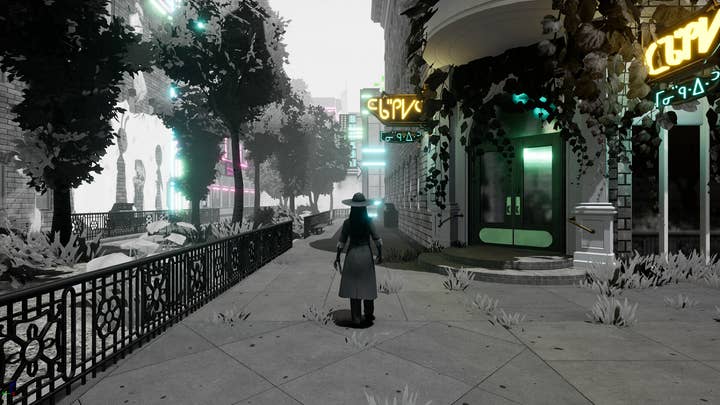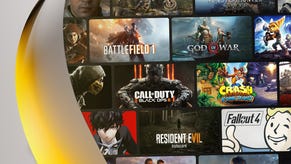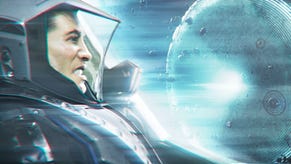Growing Indigenous worlds in games
Achimostawinan Games' Meagan Byrne and Sadekaronhes Esquivel talk about reappropriation, misrepresentation
Sign up for the GI Daily here to get the biggest news straight to your inbox
Among the presentations in last month's Game Devs of Color Expo was Achimostawinan Games' talk on Growing Indigenous Worlds in Games, which explored the themes of reappropriation and combating stereotypes of creative works for Indigenous people.
Creative leads Meagan Byrne and Sadekaronhes Esquivel also spoke about their game design inspirations for the March release Hill Agency: Purity Decay, as well as some of their frustrations.
Hill Agency takes place in the year 2762, and players assume the role of private investigator Meeygen Hill, who lives in one of the last remaining major cities in North America.
What would we do if cities just emptied because of some major natural disasters and Indigenous people reappropriated them?Meagan Byrne
Regarding how the developers settled on the setting, Byrne started to explain with a question, "What would we do if cities just emptied because of some major natural disasters and Indigenous people reappropriated them? What would these cities look like? How would they feel?"
"A lot of [these thoughts] came from my feelings of watching things, like Blade Runner, and all these cyberpunk games where they just [feature orientalism]."
Byrne noted that Turtle Island, what some people recognize as North America, is home to many native plants. So, the development duo incorporated plants everywhere in the environments and buildings of Hill Agency to visually show this connection to flora and fauna.
"The plants are everywhere; they should be everywhere," they said.

The studio acknowledged that they were working on keeping the game authentic from an Indigenous point of view. However, they noted some negative feedback regarding using a city for the game's backdrop.
Byrne said, "What's the point of tearing down anything if these are perfectly good, beautiful houses? A lot of people don't understand about these apartments that were built in New York. They're not apartments; they're stacked houses. Each floor was meant to be a one-floor house."
Esquivel added, "In our future, the brownstones we use in our game would have survived [natural disasters]."
Regarding survival, the developers noted that this also applied to other aspects of society in terms of communication and linguistics needing to change.
Byrne said, "Another thing that we thought about was, 'What would remain? What would need to be replaced or what could be amended?'"
Esquivel explained, "We have the ground city, which is much more Indigenous-based, and language regulation is happening, but there has been a loss of language. So you'd have to make up new slang as well."
They again referred to Blade Runner, which had East Asian language present in large neon signs throughout the film. While this did fall into a stereotype within the film, the Hill Agency developers were inspired to use signs to represent changes in language for the time visually.
People might look at some of our signs and think that doesn't seem right; we did this on purposeSadekaronhes Esquivel
Esquivel said, "There's a lot of things that we've gone back and forth with, such as slang…If you were personally learning a language, people might look at some of our signs and think that doesn't seem right; we did this on purpose."
The duo then shifted their talk to the designs of their characters and misconceptions non-Indigenous creatives may have of Indigenous work, which can lead to stereotypical representation.
Bryne explained, "I don't know where this idea comes from that Indigenous people don't like pieces from other cultures that we find beautiful..."
"One thing I think I bring up a lot is that there is this curated idea of what is Indigenous, and anything that doesn't fit in that curated box is not Indigenous. There's a weird disconnect that somehow, because you are Indigenous, the only things you can enjoy are in this box, which is ridiculous.
"If you've been to any reservation, you know how much the kids are into hip-hop culture and rap because it's one of the few musical genres available to them. They only have this type of rebellion music, and obviously, they'll connect with it. We have a lot in common.
"[Incidentally] when an Indigenous person does not make something, you'll know because there's an excess of Indigenous signifiers."
[Incidentally] when an Indigenous person does not make something, you'll know because there's an excess of Indigenous signifierMeagan Byrne
Esquivel noted the fictional Akomish Longhouse from Insomniac Games' 2014 title Infamous Second Son. The closest proximity to that is the Duwamish Longhouse and Cultural Center in Seattle. However, they noted the location in-game looks more similar to a Las Vegas attraction instead of the non-descript modern-day building that belongs to the Duwamish. Bryne explained this is similar to making a racist Wild West show.
As Indigenous creators, Byrne said there is a dichotomy for the creative work they would like to do and what is more palatable to potential supporters for their game projects.
They explain, "You don't have a market that expects [non-stereotypical work], and we've had this conversation come up with funders; there is a push on Indigenous creatives to go that direction [of stereotypical work].
"If you're telling me you're not going to give me money unless I make you a Wild West show, how is that consent? I think it's the same thing with like the clothes. If we wanted to create cyber powwow work, there's space for that; it's not like we don't want to do those cool things."
Sign up for the GI Daily here to get the biggest news straight to your inbox







.jpg?width=291&height=164&fit=crop&quality=80&format=jpg&auto=webp)

